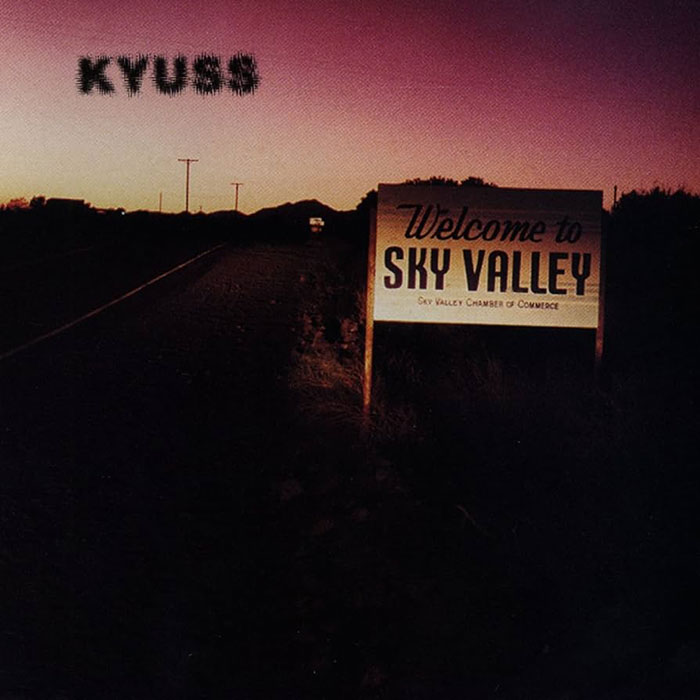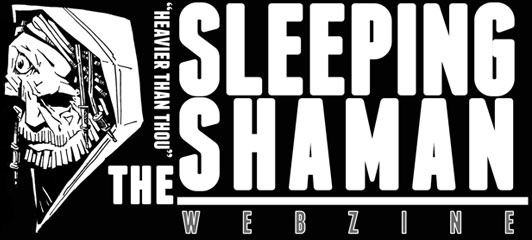Retro Review: Kyuss ‘Welcome To Sky Valley’
Any discussion about the canon of modern heavy rock, especially the style that has come to be known as ‘stoner rock’ or ‘desert rock’ absolutely must include Welcome To Sky Valley, the third album from Palm Desert, California legends Kyuss, who along with fellow Californians Fu Manchu and Sleep, as well as New Jersey’s Monster Magnet, practically invented the genre. And whilst all four bands were groundbreaking, what separated Kyuss was their absolutely massive, expansive, almost ethereal sonic assault. Already legends for their famous ‘generator parties’ that took place in the vast, Mojave Desert, Kyuss’ surroundings demanded a different musical approach.

Playing tightly wound, Black Flag-style hardcore simply wouldn’t have been nearly as effective outside in the desert. By the time Welcome To Sky Valley was released, Kyuss had already built a following with their heavy, yet somewhat primitive in comparison, debut Wretch, as well as their equally iconic second album Blues For The Red Sun, which famously got a shoutout on MTV from Dave Grohl, hailing the band and album as ‘the future of grunge’ while Krist Novoselic heartedly laughed and Kurt Cobain sat holding a baby Frances Bean.
By the time Kyuss set out to record Welcome To Sky Valley, they had jettisoned bad-boy, loose cannon bassist Nick Oliveri and replaced him with south paw Scott Reeder, a local legend who had played in the proto-desert band Across The River (along with fellow desert legend Mario Lalli) as well as serving time in Wino’s ‘90s doom metal outfit, The Obsessed. The Welcome To Sky Valley lineup; Josh Homme on guitar, Brant Bjork on drums, John Garcia on vocals and Reeder on bass crafted what has gone on to become one of the greatest, most unique heavy rock albums of all time.
Recorded in 1993 at the world-famous Sound City Studios in Van Nuys, California with an eye on a late June 1994 release, the album was originally laid out into three musical suites, literally forcing the 1990s, CD-era listener to absorb the album as a single piece of music, as opposed to skipping around looking for the ‘hit’. In fact, the album’s liner notes instructed the listener to ‘listen without distraction’.
Opening with the immortal Gardenia, which was written by Bjork, Kyuss quickly laid out their mission statement as Homme’s fuzzy, crushing guitar evokes a massive aural lava flow, while Bjork and Reeder’s rhythms are so gargantuan that, to this day, you can practically feel the rumble in your chest through the speakers while layers of tripped-out Homme effects swirl all around. When the inimitable vocals of John Garcia kick in, it’s literally game fucking over, and we’re only one song in.
Asteroid takes its time building, with a completely addicting, tonally perfect, guitar line that soon explodes into the auditory equivalent of a literal asteroid colliding with the planet. Filled with unreal starts and stops as Homme’s guitar riffs and effects whirl around them, Bjork and Reeder put on a showcase in low-end, rhythmic perfection.
Asteroid almost serves as an instrumental interlude to the mind-blowing Supa Scoopa And Mighty Scoop, a track, that still to this day, is among the greatest and most unique in all of heavy music. Homme’s intro riff, while Garcia croons ‘don’t try to take me away, like I can live without you’ serves as an appetizer before the band literally explodes into a Herculean rumbling masterpiece. The song bounces along, starting and stopping, with such exquisite timing, that by the time we get to the black hole mass of the end riff, if the listener isn’t head banging, well then, they clearly just don’t get it.
It is the definition of sonic perfection in every way, from Homme’s now-famous guitar tone and squeals to Bjork’s unrivaled, rolling drumming, to Reeder’s massive, yet tasteful low-end, to Garcia’s legendary singing and vocal delivery…
Thus, ending the first suite, the second begins with 100°, a rollicking, heavy, desert rock classic if there ever was one, wherein Space Cadet, is a tripped-out, timeless, acoustic mind-warp that literally transports the listener to another plane of reality. Garcia sings of a man waiting on the edge of the world lamenting that ‘waiting is hard, fucking takes so long’ while Homme’s cosmic, acoustic guitar and effects churn in time with Bjork’s oh-so-killer drumming.
Space Cadet, in turn, sets up one of the greatest songs in the history of heavy music, the immortal Demon Cleaner, a song that to this day, three decades later, is STILL capable of generating some serious emotions. A song so good, so epic, with such utterly killer musicianship, it practically defies logic. A song that is so revered, that not only did one of the first wave of European stoner bands name themselves after it, prog, alt-rock legends Tool themselves covered it. It is the definition of sonic perfection in every way, from Homme’s now-famous guitar tone and squeals to Bjork’s unrivaled, rolling drumming, to Reeder’s massive, yet tasteful low-end, to Garcia’s legendary singing and vocal delivery. I’m unashamed to say that this is among my favorite songs of all time, and not bad for a song about brushing one’s teeth. However, the lyrics, to me, and I’m sure to most devotees, are a metaphor for a crushing, emotional catharsis.
Entering the third suite, the rumbling of Odyssey is perfectly sequenced as an audio palette-cleanser after the emotional heft of Demon Cleaner, but this in no way diminishes its impact. Conan Troutman, is another up-tempo, rumbler with a timeless Homme riff, while N.O. is a cover of an Across The River song, serving as a tribute to the desert’s sonic forefathers. At last, we reach the album closer, to end all album closers in the iconic Whitewater, a song so epic, so vast, that listening to it, one is literally transported to Kyuss’ home in the desert. Homme’s surging, riffs and effects glide in lockstep with Bjork’s peerless drumming, while Garcia’s crooning beckons the listener to feel his emotion of being in his homeland. The ending breakdown is the stuff of legend, as the musicians are so synced with one another, it is practically inconceivable
In the end, Bjork left, disgruntled with the music business as Kyuss made one last album, the aptly named …And the Circus Leaves Town. Bjork went on to join Fu Manchu, before launching a prolific solo career, while Homme perused Queens Of The Stone Age, bringing back Oliveri, as well as the drummer who replaced Bjork, Alfredo Hernandez. Garcia formed several new bands including Slo Burn, Unida and Hermano, while Reeder served as a producer for bands like Orange Goblin, releasing solo material and auditioning for Metallica’s then-vacant bass slot.
For me, Welcome To Sky Valley’s only sonic comparisons are, and bear with me, The Beastie Boys everlasting second album Paul’s Boutique and Pink Floyd’s Animals. Obviously, neither record sound anything like Kyuss, but both beg the listener to listen to the albums as a start-to-finish sonic experience as all three continue to offer new sounds and new energy upon each listen, no matter how many times one has heard them. That is what defines a classic record.
As someone who was born, raised, and has spent most of his life in the high desert, I can completely relate to the energy Kyuss achieved in sonically conjuring the landscape, and in the interest of full-disclosure, Welcome To Sky Valley is among my ten favorite albums of all time. Needless to say, on its thirtieth anniversary, the record’s continued impact on musicians around the world cannot be understated. Listen without distraction.
Label: Chameleon | Elektra
Band Links: Spotify
Scribed by: Martin Williams



